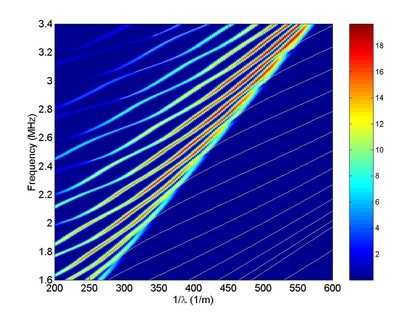Guided waves
Guided waves offer an interesting way for non-destructive testing and health monitoring of elongated civil engineering structures. They have the advantage of being able to travel long distances with little energy loss and allow for inspection of structures that are only accessible from the ends. However, in civil engineering, guiding structures are often buried or encased in solid matrices (natural material, cement, etc.). The propagation distance of the waves can be greatly reduced due to energy radiation in the surrounding environment.
The flagship application of this topic is the ultrasonic reflectometry-based monitoring of prestressed cables in order to detect and evaluate the extent of degradation, often caused by corrosion. Other structures that could potentially benefit from the developed monitoring techniques are anchorage tendons, rails, etc.
The multimodal and dispersive nature of guided waves complicates the interpretation of measurement results, making their exploitation require knowledge of propagation models. For the past few years, the GeoEND laboratory has been developing original digital modeling tools based on finite element methods dedicated to guided waves (SAFE, SAFE-PML, and hybrid FE-SAFE), taking into account various phenomena such as guide curvature, multi-strand geometry, prestressing, interaction with defects, encasement, and anisotropy. The models developed cover various NDT applications (strands, bars, tubes, plates, composites, etc.) and also apply to surface waves for geophysics (layered media, soils, pavements, dikes, cavity detection, etc.).
Associated objectives :
- Detection and localization of defects in elongated metal elements (helical cables, prestressed bars, tubes, ...)
- Development of fast direct models for the propagation of guided and surface waves for physical interpretation and optimization of monitoring systems
- Characterization of materials (damaged area in close proximity to mine galleries, search for gradients in surface concrete)
- Imaging of interfaces (damaged area in close proximity to mine galleries).
